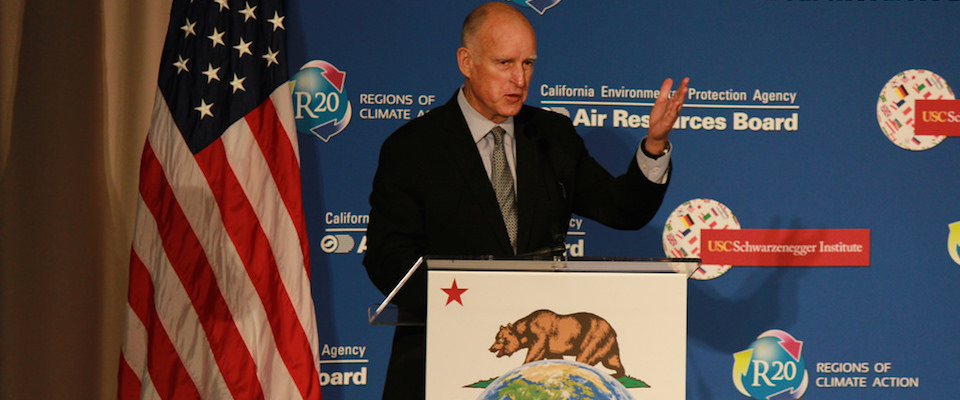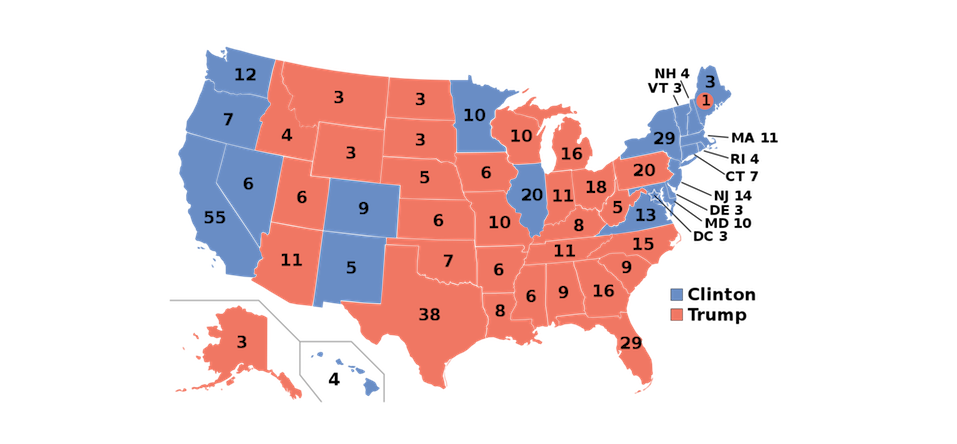Donald Trump’s recent withdrawal from the Paris climate agreement was predictable given his unrelenting attacks on the “hoax” of climate change, and the response was predictably negative, save from his fiercely partisan base. So vigorous was the dissent that the governors of California, New York, and Washington immediately announced the United States Climate Alliance, now composed of 13 states vowing to uphold the Paris accords within their respective borders.
That’s not mere window dressing, considering the three states account for about 20 percent of both the U.S. population and gross domestic product. But what’s the bottom line? How will Trump’s move—and the governors’ response—play out in real economic and environmental terms?
“Like other actions the President has pursued, it tells the world the United States will go it its own way, or rather, Trump’s way, on matters that affect global security and stability.”
First, it should be remembered that the Paris tenets are nonbinding, allowing signatories (every country in the world except Nicaragua and Syria) to establish their own greenhouse gas emission reduction goals. So compared to some other actions Trump has taken—most notably his executive order rescinding the Obama Administration’s Clean Power Plan, which would shutter hundreds of coal-fired power plants and halt construction of new ones—withdrawing from the Paris climate agreement is relatively inconsequential in terms of short-to-mid-term effects.
But the message the move sends is consequential, says Daniel Farber, UC Berkeley Law professor and the co-director of the University’s Center for Law, Energy, and the Environment. Like other actions the President has pursued, it tells the world the United States will go it its own way, or rather, Trump’s way, on matters that affect global security and stability.
“Messaging on critical issues like climate change is extremely important,” says Farber. “The Paris agreement didn’t provide any enforcement. It doesn’t designate a climate sheriff. The UN isn’t going to send troops in if milestones aren’t met. But like the Kyoto accords [an earlier climate change agreement], it is part of a framework for international cooperation. And to a real degree, nations will comply depending on what they expect everyone else to do – especially depending on what the global leader, the United States, does. So yes, it is significant that Trump withdrew.”
Daniel Kammen, a professor in the Energy and Resources Group at the Goldman School of Public Policy and the director of Cal’s Renewable and Appropriate Energy Lab, largely agrees with Farber. The United States, he says, technically can’t withdraw from the Paris agreement until 2020, and Trump’s move will have less effect than other actions; not only has the President rescinded the Clean Power Plan, says Kammen, but he has rolled back mileage and greenhouse gas emission standards for new vehicles.
“China has just invested [more than] $300 billion in clean energy. Ultimately, that’s going to translate to about a trillion dollars in lost job opportunities for the United States.”
“He’s been steadily chipping away [at greenhouse gas emission standards], so walking away from Paris doesn’t mean much in terms of impacts,” Kammen says. “In any case, the signatories aren’t going to meet their targets [keeping global temperature rises to “well below” two degrees Celsius above pre-Industrial Revolution numbers, with a goal of no more than 1.5 degrees Celsius]. What withdrawal does establish is that the U.S. is no longer a major player in climate change response and policy, and that will affect where the investments go. China has just invested [more than] $300 billion in clean energy. Ultimately, that’s going to translate to about a trillion dollars in lost job opportunities for the United States. Trump has essentially ceded leadership. That’s why [Secretary of State and former Exxon CEO] Rex Tillerson argued that we should’ve stayed with the agreement; he understands the economic consequences.”
While Trump’s moves were made to save American jobs, says Kammen, they’ll likely have the opposite effect, particularly in the economically depressed Midwestern states that secured his victory.
“Our research indicates that investing in solar and wind power yields two to five times the jobs that a similar investment would produce in the fossil fuel sector,” says Kammen. “The irony is that Trump’s rescinding of the Clean Power Plan is going to hit the Midwestern red states the hardest. The rule would’ve cut greenhouse gas emissions by a third by 2025 and established an $8 billion fund to support clean-up jobs and other benefits for affected states. That would’ve provided a lot of economic opportunity for poor and struggling red state communities.”

“The coal industry has dwindled by 90 percent in the last decade,” says Kammen, “and total investment for the entire sector now stands at less than $50 billion. Bill Gates could buy it at 1.5 to two times over and shut it down if he wanted.”
Indeed, coal’s problems are affected by market forces more than policy, observes Severin Borenstein, a professor and energy research associate at the Haas School of Business. Cheap natural gas—a fossil fuel that produces only about half the greenhouse emissions of coal—is a leading reason for coal’s decline. Borenstein cites a recent analysis of the coal industry by Charles Kolstad, a senior fellow at the Stanford Institute for Economic Policy Research and the lead author for the Intergovernmental Panel on Climate Change, that concluded the aging state of coal-fired power plants and modern mining technologies that require fewer workers are also contributing factors.
“What is clear,” wrote Kolstad, “…is that environmental regulations did not kill coal. Progress is the culprit.”
“California is doing real stuff,” says Wolfram.
That noted, moves by Jerry Brown and other state governors to address climate change are yielding concrete results, says Catherine Wolfram, a Cal professor of business administration and the faculty director at the Haas Energy Institute.
“California is doing real stuff,” says Wolfram. “We’re investing a lot of money into renewable energy, including a grand experiment to encourage high penetration of into the electrical grid. We’ve adopted a portfolio standard calling for 33 percent renewable energy in total procurement by 2020 and half by 2030, and we’re meeting our targets.”
Kammen is a big Brown fan, calling the governor a phenomenal leader in climate change response. He says that California’s alliance with Washington and New York states will keep a significant portion of the nation’s economy moving toward emissions reduction, and he notes Brown recently signed an agreement with China to work toward accelerated emissions cuts and increased trade in green technologies.
“Because of sub-national efforts like Under2 and the climate alliance, it’s likely a lot of numeric goals for greenhouse gas emissions will be met.”
An initiative with even greater potential for advancing renewable energy is the Under2 MOU, a memorandum of understanding among the planet’s “sub-national jurisdictions”—states, provinces, and cities—to reduce and mitigate greenhouse gas emissions. Signed by 12 founding governments in Sacramento in 2015, the number of signatories has since grown to 165, encompassing one billion people and accounting for a third of the global economy.
“It was originally conceived by California and the German state of Baden-Wuerttemberg, and people like Brown and Angela Merkel are its spiritual leaders,” says Kammen. “I wouldn’t want to oversell it, but it does demonstrate that terrible federal policy doesn’t necessarily slow down the action of willing partners. Trump’s decisions probably will convince some [global] leaders who are sitting on the climate change fence to continue sitting there, and that could very well slow down innovation. But because of sub-national efforts like Under2 and the climate alliance, it’s likely a lot of numeric goals for greenhouse gas emissions will be met.”
While Trump’s withdrawal from the Paris agreement, his putative disbelief in climate change, and general hostility toward environmental regulation distress many Americans, Farber recommends taking the long view.
“We have no idea how long his administration will last, or how long his policies will stay in effect,” Farber says. “Certainly, economic trends are against them. Even if his policies remain in place until 2030, which is by no means certain, it might slow coal’s decline, but it’s highly unlikely it could reverse it. It’s like King Canute telling the tide to stop coming in. It isn’t going to happen. But a lot of damage could be done until things change. The question is, how much?”





















